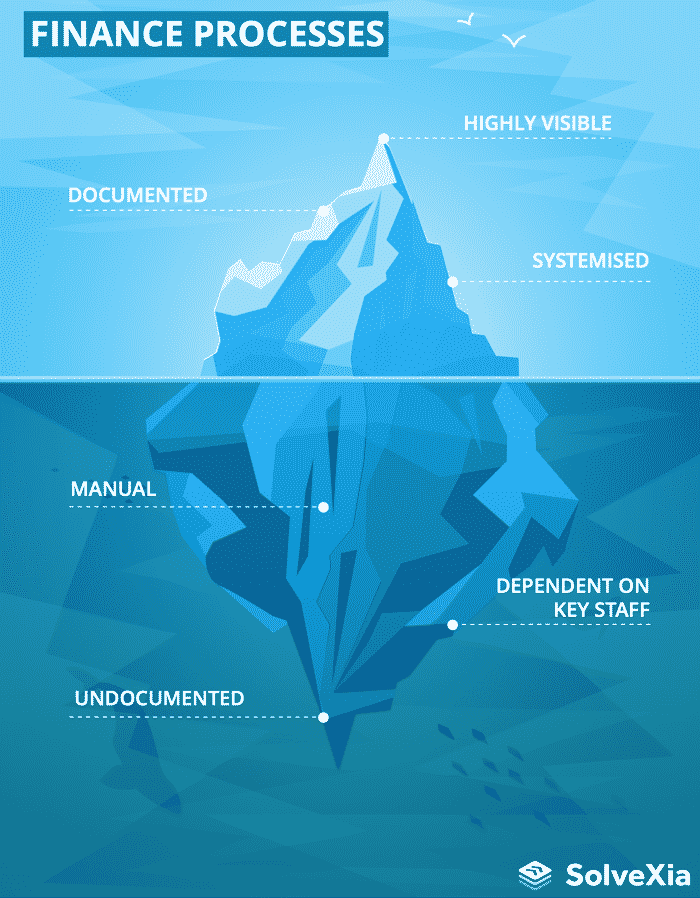3 ways CFOs can deal with bottlenecks

Process bottlenecks represents a key source of frustration for many finance leaders. They can result in missed deadlines, stressed and overworked staff and embarrassing errors.
Deloitte estimates that finance departments spend almost 50% of their time creating reports. Amongst this monumental data processing effort are low-visibility tasks that can become bottlenecks.
The role of finance and the CFO is evolving with greater emphasis on analysis and insights. To allow finance staff to grow and refocus their efforts in line with their new role, CFOs must address bottlenecks.
Read on to learn:
- Why processes in the finance department are like an iceberg.
- The impact of below-the-surface processes that become bottlenecks.
- 3 actions you can take to help address the issue of process bottlenecks.
Your processes are an iceberg.
Imagine processes in the finance department as an iceberg. High visibility tasks, like preparing tax returns, sit above the surface. Tasks with a high visibility tend to be well understood and documented. They are also systemised (at least partially):

Below the surface lives a trove of processes that are less well known. These tasks, for creating reports and preparing data, are often:
- Undocumented.
- Rely on a small number of subject matter experts (as little as one person).
- Manual. Performed in spreadsheets.
The HR effort that companies pour into these below-the-surface tasks is huge. As much as 50% of finance staff's time.
Many of these tasks produce data for downstream processes. The problem is when these tasks become bottlenecks with cascading effects on finance.
Don't ignore bottlenecks below the surface.
Below-the-surface tasks that become bottlenecks can have reverberating effects on the finance department. Deadlines can be missed. Staff work over weekends to submit regulatory filings on time. Mistakes get made.
A recent article from CFO Magazine highlighted a good example of this:
- A company needs to file a tax return.
- Tax specialists wait for financial data that gets loaded into income tax system to produce a trial balance.
- A delay in getting the financial data results in a delay in doing the tax work.
- The delay reduces the time staff have available to prepare, review and file taxes.
- Staff rush and work weekends to prepare the tax return, making errors as a result.
- The delay in financial data acts as a bottleneck, impacting the more critical task of filing a tax return.
A good model to understand the impact of bottlenecks is Theory of Constraints (TOC). Introduced in 1984, TOC is a popular management paradigm for addressing bottlenecks:

For many CFOs and finance leaders, below-the-surface processes become the bottlenecks. This in turn hampers the finance departments ability to meet business expectations.
The first step, therefore, is to identify the bottlenecks across finance.
Next, we will discuss the actions you can take to mitigate the risk of bottlenecks within finance.
Action 1: Avoid rework (in the bottleneck task).
Imagine you have a four-hour task that has become a bottleneck for month-end reporting. What can be worse? Having that four-hour task turn into eight-hours because of erroneous input data.

You need to ensure that:
- Data going into the bottleneck task is valid and clean before processing begins; and
- Staff are available for reviewing and approving outputs (to mark the task as complete).
We presented a webinar on data quality best practices. Some good practices to follow include:
- Get as close to the source data as possible (avoid data that comes from upstream spreadsheets).
- Have a clear profile of the input data needed. This includes granularity, age, frequency and availability of the data.
- Catch and resolve data quality issues as early as possible. Follow the 1-10-100 rule (learn more).
- Measure and act on data quality issues. Have automated solutions in place to deal with recurrent data issues.
Staff also need to be aware that their process is critical for downstream activities. As such, key staff need to be available to not only do the work but also review and approve outputs. The last thing you want is for a 0.5 day task to turn into a full day as you chase a manager for their approval.
Action 2: Minimise downtime. Increase work capacity (if possible).
Process downtime occurs for a variety of reasons. The most common reason is that key staff are off sick or on leave.

Finance leaders have a responsibility to minimise the downtime of bottleneck tasks. This includes ensuring that the bottleneck task is:
- Transferable. Can a new staff member pick up the task and complete it?
- Documented. Is it easy for the new staff member to understand the process and complete it as intended?
- Accessible. Do replacement staff have access to the data and systems necessary to do the job?
- Self-validating. Are there any prescribed validations and checks to flag errors for the new staff member?
Another option - which may be a luxury for some companies - is to share and spread the bottleneck task after hours. This is a viable solution for teams that span timezones. For example, Sally works on preparing a report from 4 - 6pm. Her colleague in a later timezone then spends 2 hours completing the report. As a result, the team completes the report in time for downstream tasks the following morning.
Action 3: Make the bottleneck task more efficient.
After dealing with downtime and rework the next action should focus on efficiency. How do you reduce that four-hour bottleneck task into a two-hour task?

There are many ways to make a task more efficient. It could be as simple as reallocating the job to someone who works faster. In most cases, you will need to iterate through a series of improvements. For example you can:
- Cut steps that are not necessary. This could include eliminating outputs that are not actually used downstream.
- Look across processes to identify and remove duplicate work. For example, it is not uncommon to see two staff perform the same data cleansing work on a source data file.
- Re-engineer and simplify the processing. This can range from simplifying a spreadsheet to re-engineering an entire workflow.
- Train staff in areas such as time management and productivity.
- Equip staff with better tools such as a faster computer.
It is important to view efficiency as a journey rather than an end-state. Rather than setting lofty and expensive goals, organisations must embrace continuous improvement:
- Look to smaller, more iterative efficiency gains.
- Measure the efficiency gains - what impact has it had on wider finance?
- Use the success of an efficiency gain to justify further improvements to the process.
Automation is the answer for the actions 1, 2 and 3.

To recap, there are three actions to take in relation to bottleneck tasks that plague finance:
- Avoid rework (for the bottleneck task).
- Minimise downtime and spread the work across timezones (if possible).
- Make the bottleneck task more efficient.
Automation is a powerful tool for addressing all three actions. This is because automation:
- Allows you to ensure the quality of data inputs. Automated processes can check input data before it gets to the bottleneck task.
- Runs 24/7. Automated solutions don't get sick or take annual leave.
- Is transferrable. New staff can take over the orchestration of a process.
- Aids with knowledge transfer by documenting the bottleneck task. This further mitigates the risk of downtime and key person dependency.
- Finishes repetitive data tasks much faster than humans (10x faster).
- Acts as a catalyst for re-engineering and process simplification.
Referencing the iceberg analogy, automation moves processes to the surface. Once automated, processes are visible. In turn, this helps finance leaders get a handle on critical bottlenecks. To address a problem, you first need to know that it exists.
Conclusion
CFOs and finance leaders are scrambling to meet the evolving needs of their CEO and business. Process bottlenecks, if left unattended, will limit the effectiveness of the finance organisation.
The processes across the finance organisation form an iceberg. Many processes reside below the surface. These processes are often undocumented, manual and rely on key staff to get work done. These below-the-surface tasks can easily become bottlenecks resulting in missed reporting deadlines.
Finance leaders must address and mitigate the issue of bottlenecks. To do this, companies must:
- Avoid rework (for the bottleneck task).
- Minimise downtime and spread the work across timezones (if possible).
- Make the bottleneck task more efficient.
Automation is a powerful tool that can help finance leaders execute on actions 1-3 above.
To learn more about the challenges facing CFOs who want to automate, please download our free whitepaper.
FAQ
Intelligent reconciliation solution
Intelligent rebate management solution
Intelligent financial automation solution
Intelligent Financial Automation Solution
Intelligent financial automation solution
Intelligent financial automation solution
Intelligent financial automation solution
Intelligent financial automation solution
Intelligent regulatory reporting solution
Free up time and reduce errors
Recommended for you

Request a Demo
Book a 30-minute call to see how our intelligent software can give you more insights and control over your data and reporting.

Reconciliation Data Sheet
Download our data sheet to learn how to automate your reconciliations for increased accuracy, speed and control.

Regulatory Reporting Data Sheet
Download our data sheet to learn how you can prepare, validate and submit regulatory returns 10x faster with automation.

Financial Automation Data Sheet
Download our data sheet to learn how you can run your processes up to 100x faster and with 98% fewer errors.

Financial Automation Data Sheet
Download our data sheet to learn how you can run your processes up to 100x faster and with 98% fewer errors.

Financial Automation Data Sheet
Download our data sheet to learn how you can run your processes up to 100x faster and with 98% fewer errors.

Financial Automation Data Sheet
Download our data sheet to learn how you can run your processes up to 100x faster and with 98% fewer errors.

Financial Automation Data Sheet
Download our data sheet to learn how you can run your processes up to 100x faster and with 98% fewer errors.

Financial Automation Data Sheet
Download our data sheet to learn how you can run your processes up to 100x faster and with 98% fewer errors.

Rebate Management Data Sheet
Download our data sheet to learn how you can manage complex vendor and customer rebates and commission reporting at scale.

Top 10 Automation Challenges for CFOs
Learn how you can avoid and overcome the biggest challenges facing CFOs who want to automate.
.svg)



